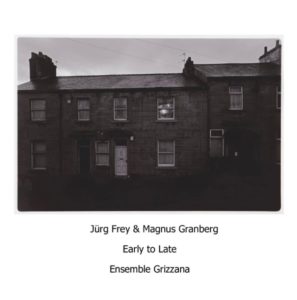 Het album ‘Early to Late’ ontstond naar aanleiding van een compositie opdracht die Another Timbre gaf aan Magnus Granberg en Jürg Frey, met als enige eis dat de componisten een tweetal renaissancecomposities als uitgangspunt namen: Déploration sur la mort de Binchois’ van Johannes Ockegem en ‘O Lord, How Vain’ van Wiiliam Byrd. Beide nieuwe stukken werden vorig jaar november tijdens het Huddersfield Contemporary Music Festival door Ensemble Grizzana, met daarin onder andere Granberg en Frey, in première gebracht en kort daarna door Simon Reynell, de man achter Another Timbre opgenomen.
Het album ‘Early to Late’ ontstond naar aanleiding van een compositie opdracht die Another Timbre gaf aan Magnus Granberg en Jürg Frey, met als enige eis dat de componisten een tweetal renaissancecomposities als uitgangspunt namen: Déploration sur la mort de Binchois’ van Johannes Ockegem en ‘O Lord, How Vain’ van Wiiliam Byrd. Beide nieuwe stukken werden vorig jaar november tijdens het Huddersfield Contemporary Music Festival door Ensemble Grizzana, met daarin onder andere Granberg en Frey, in première gebracht en kort daarna door Simon Reynell, de man achter Another Timbre opgenomen.
Dat Granberg zich vooral door Byrd liet inspireren blijkt uit de titel: ‘How Vain Our Frail Delights?’ waarin hij verwijst naar de regel: “O, Lord How Vain”, een regel die Granberg persoonlijk aanspreekt. Voor zijn stuk gebruikt hij citaten en fragmenten uit zowel het stuk van Byrd als dat van Ockegem als basis voor zijn eigen stuk, dat overigens een gelijksoortige structuur kent als veel van Granbergs werk en waarover hij zelf zegt: “my piece basically consists of a few different pools of materials (containing melodic and rhythmic fragments, extended melodies, single notes, chords, suggestions regarding timbre etc.) notated in conventional staff notation, along with some suggestions as to how to treat them, as well as a temporal structure which regulates when to play from which group of materials. Within these groups or pools of materials the musicians are free to choose what to play and when to play it, and the final outcome is very much a result of the superimpositions, juxtapositions and interactions of the musical materials, as well as of individual and collective processes of listening, deciding (intuitively or consciously), acting and interacting, or not interacting, with one another.” Er zit dus duidelijk een relatie met improvisatie in dit stuk, al zijn de kaders gegeven. Bijzonder in het stuk is de ‘cantus firmus’, de bastoon die veel Renaissancemuziek kenmerkt. Hier een partij voor de klarinet, op dit album gespeeld door Frey, die continu als een licht verkleurende muzikale lijn aanwezig is.
Zoals Frey zelf aangeeft heeft de titel ‘Late Silence’ parallellen met het stuk van Ockegem, maar verwijst het ook naar dat wat de muziek van Frey zo sterk kenmerkt: het gebruik van stilte. Waar Granberg met name Byrd als uitgangspunt nam, daar koos Frey primair voor Ockegem. Hij zegt verder over het stuk: “The materials from Ockeghem and Byrd are used literally or slightly changed. So, for example, at the beginning of the piece, the hammered dulcimer and clarinet play the Byrd tune (and later Ockeghem, and then again Byrd), the violins play the Ockeghem melody, rhythmically transformed, and I myself added two notes for the piano, “a” and “g”. This behaviour regarding the material is established at the very beginning in a strict way, and is also effective for decisions through the whole piece.”
Vooral Frey weet met zijn stuk de luisteraar mee te nemen. Bijzonder is het gebruik dat hij maakt van stenen die door Granberg en John Lely in cirkelgang over een glad oppervlak worden bewogen. Het levert een bijzonder effect op en werkt beslist spanningsverhogend.
Lees hier een interview met Granberg en Frey over ‘Early to Late’.
Beluister hier fragmenten van de twee composities:

